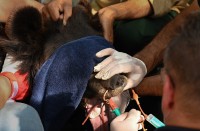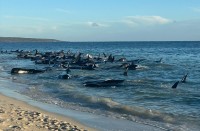California sea lions – mainly pups – are turning up stranded and starved on Southern California beaches in record numbers this year, leaving experts worried that this winter may be the worst season ever documented for the marine mammals.
The precise cause is not clear, but scientists believe the sea lions are suffering from a scarcity of natural prey that force nursing mothers to venture farther out to sea for food, leaving their young behind for longer periods of time.
Experts theorize that this winter’s mild El Nino effect, which alters ocean currents and temperatures, may be compounding the shortage of fish that sea lions rely on for food.
Animal care rescue workers in San Pedro, California routinely take phone calls from beach-goers who see the stranded pups. Rescue staffs are concerned that their facilities and resources will not be enough to rescue all the animals.
“Our facility as well as others in Southern California are at, or nearing, capacity. We’re doing everything we can to work with rescue agencies and bring in as many patients as we can. The fact of the matter is this year, because of the inordinate numbers, we’re not going to be able to save every single animal on the beach,” says David Bard, the coordinator of the Marine Mammal Center in San Pedro.
Staff at the Marine Mammal Center care for the animals and rehabilitate them. Once the animals can survive in the wild they are released from the center.
Bard and the center have already taken in over 330 of the starving animals.
“This year we’re predominantly seeing underweight animals. These animals should be in the 50 to 60 pound (22-27 kilos) range, and they are coming in a fraction of that,” said Bard.
So far this year, a record 1,450 starving pups have been rescued in Southern California.
The pups are usually born in June and July and nurse until January, remaining on the shore while their mothers go to sea for food.
Raymond Wilson, a professor of Marine Biology at the California State University, Long Beach, believes mothers are being forced to abandon their pups.
“It could also be that the food supply is become diminished for some reason, sort of out under the population. But in any event, the reports are that the pups are coming ashore underfed and malnourished so, the evidence is they are not getting enough to eat. So for whatever reason, whether they overrun their food supply or the food supply has gone out from under them, apparently the mothers aren’t finding enough food to sustain the pups and probably abandoning them.”
Commercial enterprises have also come to the rescue. Last Friday (March 13) SeaWorld shut down its sea lion shows so that the San Diego-based company could use the staff and facilities – including building two temporary pools for the pups – in anticipation of more rescues. SeaWorld has taken in nearly 500 of the starving animals, according to SeaWorld spokeswoman Kelly Terry.
(Reuters)







